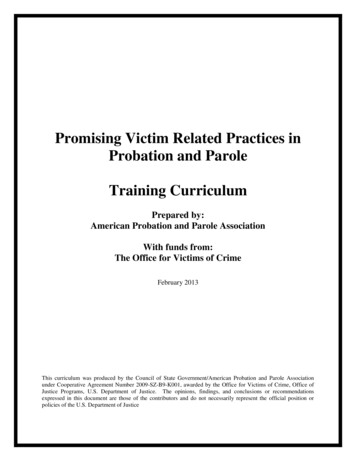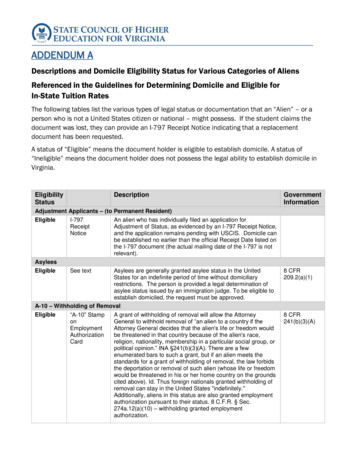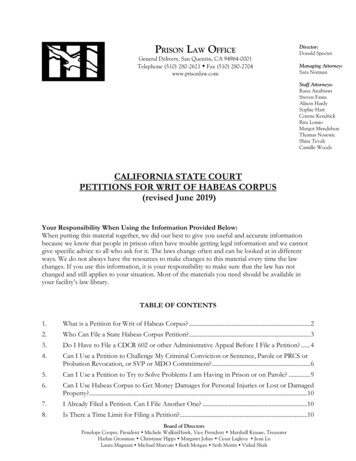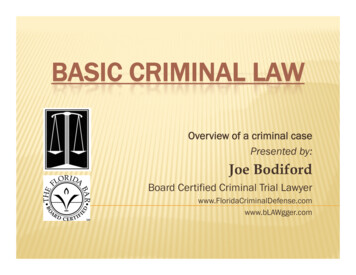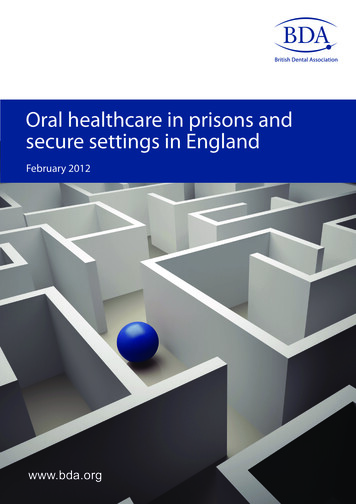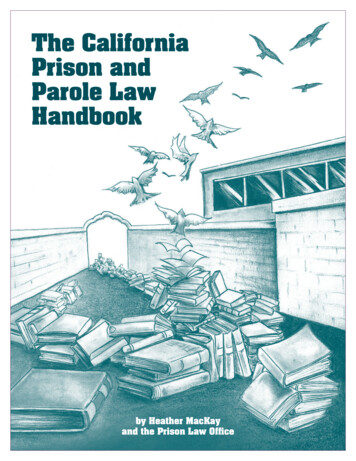
Transcription
The CaliforniaPrison andParole LawHandbookby Heather MacKayand the Prison Law Office
THE CALIFORNIAPRISON & PAROLE LAWHANDBOOKBY HEATHER MACKAY&THE PRISON LAW OFFICEISBN: 978-0-692-95526-0Copyright 2019 by the Prison Law OfficeContent Editor: Ritika AggarwalProduction & Style Editor: Brandy IglesiasCover Art: Justus EvansCover Design: Tara EglinAssistance with Chapter 9: Kony Kim, former Staff Attorney at UnCommon Law, a non-profitthat represents people at Board of Parole Hearings proceedings, challenges unjust parole policiesand decisions, and provides training and information to people serving life terms and theiradvocates.Assistance with Chapter 11: Anne Mania, former Staff Attorney at the Prison Law Office andRosen, Bien, Galvan and Grunfeld, where she worked on ensuring due process for peopleundergoing parole violation processes.Assistance with Chapter 13: Theo Cuison, Deputy Director and Clinical Supervisor in theImmigration Unit of the East Bay Community Law Center (EBCLC), a clinic of U.C. BerkeleySchool of Law.
The Prison Law Office is a non-profit public interest law firm that strives to protect the rightsand improve the living conditions of people in state prisons, juvenile facilities, jails and immigrationdetention in California and elsewhere. The Prison Law Office represents individuals, engages in classactions and other impact litigation, educates the public about prison conditions, and provides technicalassistance to attorneys throughout the country.Order forms for The California Prison and Parole Law Handbook are available at:www.prisonlaw.com or by writing to:Prison Law OfficeGeneral DeliverySan Quentin, CA 94964In addition, many self-help information packets on a variety of topics are available free ofcharge on the Resources page at www.prisonlaw.com or by contacting the Prison Law Office at theaddress above.***YOUR RESPONSIBILITY WHEN USING THIS HANDBOOKWhen we wrote The California Prison and Parole Law Handbook, we did our best to provide usefuland accurate information because we know that people in prison and on parole often have difficultyobtaining legal information and we cannot provide specific advice to everyone who requests it.However, the laws are complex change frequently, and can be subject to differing interpretations.Although we hope to publish periodic supplements updating the materials in the Handbook, we donot always have the resources to make changes to this material every time the law changes. If you usethe Handbook, it is your responsibility to make sure that the law has not changed and is applicable toyour situation. Most of the materials you need should be available in a prison law library or in a publiccounty law library.
§ 1.1CHAPTER 1ADMINISTRATIVE APPEALS1.1IntroductionEXHAUSTION OF ADMINISTRATIVE REMEDIES1.2Overview of Exhaustion of Administrative Remedies Requirements1.3Exhaustion of Administrative Remedies – State Petitions for Writ of Habeas Corpus orMandate1.4Exhaustion of Administrative Remedies – Federal Petitions for Writ of Habeas Corpus1.5Exhaustion of Administrative Remedies – Federal Civil Rights (§ 1983) Lawsuits1.6Exhaustion of Administrative Remedies – State Tort Lawsuits and Small Claims LawsuitsTHE CDCR ADMINISTRATIVE APPEAL PROCESS1.7The Right to File an Administrative Appeal1.8Rights to Assistance in Preparing or Understanding an Administrative Appeal1.9Overview of CDCR Administrative Appeal Procedures (CDCR Form 602)1.10 Informal Request for Interview, Item, or Service (CDCR Form 22)1.11 Time Limits for Filing a CDCR Administrative Appeal1.12 Time Limits for Responses to a CDCR Administrative Appeal1.13 Preparing and Filling an Administrative Appeal1.14 Filing a Group Administrative Appeal1.15 Filing an Emergency Administrative Appeal1.16 Rejection of an Administrative Appeal1.17 Cancellation of an Administrative Appeal1.18 Abuse of the Administrative Appeal System1.19 Withdrawal of an Administrative Appeal1.20 First Level Review1.21 Second Level Review1.22 Third Level Review1.23 Delayed or Lost Administrative Appeals1.24 Retaliation for Filing Administrative AppealsSPECIAL ADMINISTRATIVE APPEAL PROCESSES1.25 Health Care Grievances and Administrative Appeals (CDCR Form 602-HC)1.26 Disability Accommodation Requests (CDCR Form 1824)1.27 Administrative Appeals Regarding Lost and Damaged Property1.28 Administrative Appeals Regarding Staff Misconduct1.29 Administrative Appeals Regarding Sexual Abuse by Staff or Other People in Prison1.30 Administrative Appeals Regarding Disciplinary Violations1.31 Administrative Appeals Regarding Transfers1
§ 1.11.321.331.341.351.361.371.38Administrative Appeals Regarding Visiting and MailAdministrative Appeals Regarding Release Date, Credit, and Parole Period ComputationsAdministrative Appeals Regarding the Prison Industries Authority (PIA)Administrative Appeals Regarding a Joint Venture ProgramAdministrative Appeals Regarding Parole Location, Conditions and DischargeBPH Parole Suitability Administrative AppealsBPH Parole Hearing Disability Accommodation Appeals (BPH Forms 1073 and 1074)OTHER TYPES OF ADMINISTRATIVE COMPLAINT PROCESSES1.39 An Overview of Other Types of Administrative Complaint Processes1.40 CDCR Ombudsman1.41 CDCR Office of Internal Affairs1.42 Office of the Inspector General1.43 Citizen’s Complaints1.44 State Personnel Board Complaints1.45 Medical Board Complaints1.1IntroductionPeople in prison or on parole may want to challenge or complain about the actions of a prisonor parole official or a prison or parole regulation or policy. This can be done by filing a written“administrative appeal” with the California Department of Corrections and Rehabilitation (CDCR).1The CDCR has administrative appeal forms and processes for various types of issues. The processesgenerally involve filling out and filing a form for review by a lower-level prison official and then, ifnecessary, re-submitting the form for review by higher-ranking officials.An administrative appeal should almost always be the first step in trying to resolve a prison orparole problem. Staff might grant the request or provide an explanation for denying the request,allowing the person in prison or on parole to avoid time-consuming and complicated legalproceedings. At the very least, the administrative appeal will document the problem and the person’sattempts to address it. Indeed, a person in prison or on parole usually must complete the administrativeappeal process before a court will hear any type of case complaining about a CDCR policy or action.The final sections of the chapter discuss other tools that people in prison and their advocateshave for raising concerns about prison policies, prison conditions or staff misconduct.12Administrative appeals are different from “direct appeals,” in which trial court judgments, such as criminalconvictions, are reviewed by a higher court. Direct appeals of criminal convictions are discussed in Chapter 14.
§ 1.2EXHAUSTION OF ADMINISTRATIVE REMEDIES1.2Overview of Exhaustion of Administrative Remedies RequirementsCourts usually will not hear a formal legal action challenging prison or parole policies,conditions, or actions unless a person in prison or on parole first completes an administrative appealprocess. This is known as the “exhaustion of administrative remedies” requirement. Because of thisrequirement, a court is likely to dismiss any prison- or parole-related lawsuit unless the person inprison or on parole has pursued an administrative appeal on the issues through the highest availablelevel of review.There are several reasons for this requirement. The CDCR has the responsibility to administerthe prison and parole systems, and should have the first chance to investigate and correct problems.Requiring exhaustion also conserves judicial resources, because an administrative appeal may resolvean issue, eliminating the need for a court to get involved.2 An administrative appeal can also benefit alegal position by establishing the underlying facts or demonstrating that officials were made aware ofthe problem but failed to correct it.It is important to be aware that exhaustion of administrative remedies is required only if theprison or parole agency has an administrative appeal process. The CDCR has a general administrativeappeals process for most prison and parole issues (see §§ 1.9-1.22) and specialized appeal processesfor some particular issues (see §§ 1.25-1.36). The Board of Parole Hearings (BPH) has noadministrative appeal process except for requests for disability accommodations, challenges to factualerrors in risk assessments, and challenges to denial of Proposition 57 early parole or youthful offenderparole (see §§ 1.37-1.38). Thus, there is no need for a person to file an administrative appeal beforebringing a court action challenging a BPH decision or policy, unless the matter involves one the limitedmatters for which an administrative appeal can be filed.There are no CDCR administrative remedies to exhaust if the CDCR does not have authorityover the matter at issue. For example, if a criminal court did not grant the proper number of presentence credits or imposed an illegal sentence, a person in prison does not need to file anadministrative appeal because the CDCR has no power to award pre-sentence credits or change asentence. Also, legal actions against other state agencies may be filed without exhausting the CDCRadministrative appeal process; of course, other agencies may have their own grievance procedures.3Specific exhaustion requirements for several types of legal actions commonly used by peoplein prison and on parole – state habeas corpus and mandate, federal habeas corpus, federal civil rightslawsuits, and state tort lawsuit -- are discussed in the following sections. These sections also describecircumstances in which courts may excuse a failure to exhaust administrative remedies or find thatthere are no available administrative remedies. (§§ 1.2-1.6).Even when a court might allow someone to proceed without exhausting administrativeremedies, they should still make good efforts to start the administrative appeal process as soon aspossible. At the very least, the person should file an administrative appeal at the same time the petition2Woodford v. Ngo (2006) 548 U.S. 81, 89 [126 S.Ct. 2378; 165 L.Ed.2d 368]; In re Muszalski (1975) 52 Cal.App.3d 500,505-506 [125 Cal.Rptr. 286].315 CCR § 3084.1(a); 15 CCR § 3084.6(c)(1).3
§ 1.3or complaint is sent to the court; a person in prison who is in imminent danger of suffering significantharm can request emergency appeal processing (see § 1.15). Telling the court that an administrativeappeal has been filed will show that the person really is trying to resolve the problem. Also, a personwho already has an administrative appeal in the system will be able to get back into court more quicklyif the court refuses to excuse a failure to exhaust administrative remedies.In addition to getting the administrative appeal process started, a lawyer or advocate for theperson in prison can contact prison officials about the problem, particularly if the matter poses a riskof irreparable harm. The lawyer or advocate can write, telephone, e-mail, or send a fax to the prison’sLitigation Coordinator or Warden, stating what the problem is and what action is being requested.Even if these efforts are unsuccessful, someone may be able to argue to the court that prison officialshad fair notice of the problem and opportunity to resolve it, and any further administrative appealswould be futile.1.3Exhaustion of Administrative Remedies – State Petitions for Writ of HabeasCorpus or MandatePeople in prison or on parole in California commonly file state court petitions for writ ofhabeas corpus to challenge conditions of their incarceration or parole (see Chapter 15). A courtgenerally will not consider a state habeas petition unless they have completed the appropriateadministrative appeal process through the highest level of review.4 Likewise, a person usually mustcomplete an administrative appeal before filing a state court petition for a writ of mandate (see §§15.30-15.43).5There are circumstances in which courts can and should make exceptions to the exhaustionof administrative remedies requirement for state court habeas and mandate petitions. “[T]he doctrineof exhaustion of administrative remedies has not hardened into inflexible dogma. [Citation.] Itcontains its own exceptions, as when the subject matter of the controversy lies outside theadministrative agency's jurisdiction [citation], when pursuit of an administrative remedy would resultin irreparable harm [citations], when the administrative agency cannot grant an adequate remedy[citations], and when the aggrieved party can positively state what the administrative agency's decisionin his particular case would be.”6 In such situations, courts can allow the case to proceed even thoughthe person has not filed an administrative appeal or has not completed the whole process. Commonlyrecognized exceptions include the following:4In re Strick (1983) 148 Cal.App.3d 906, 911 [196 Cal.Rptr. 293]; In re Dexter (1979) 25 Cal.3d 921, 925 [160 Cal.Rptr.118]; In re Muszalski (1975) 52 Cal.App.3d 500, 503-505, 508 [125 Cal.Rptr. 286].5Sail’er Inn, Inc., v. Kirby (1971) 5 Cal.3d 1, 7 [95 Cal.Rptr. 329].6Ogo Associates v. City of Torrance (1974) 37 Cal.App.3d 830, 834 [112 Cal.Rptr. 761].4
§ 1.4 No administrative remedy is available or the administrative process is inadequate toaddress the issue.7 Seeking an administrative remedy would be futile because the CDCR action is consistentwith a clear policy or rule or because the CDCR has consistently defended the policy orrule against similar challenges.8 This exception does not apply if it is reasonably possiblethe agency will change or override its policy based on the facts of a particular case.9 Taking the time to exhaust administrative remedies would cause the person to suffer anunreasonable risk of irreparable harm.10 Risk of irreparable harm might exist wheremedical or safety concerns are causing great pain or high risk of serious injury. The samemight be true if a person is being held past their lawful release date. However, the merefact that a constitutional right is being violated does not necessarily amount to irreparableharm.11A person who files a state habeas or mandate petition before completing the administrativeappeal process should explain why the court should make an exception to the exhaustion requirement.They should also describe any other efforts that have been made to inform prison officials about theproblem and should attach any documents that would support an argument that the court should goahead and hear the case.1.4Exhaustion of Administrative Remedies – Federal Petitions for Writ of HabeasCorpusA person in prison or on parole in California (or other state prison) can use a federal petitionfor writ of habeas corpus to challenge the legality or duration of confinement. Usually, such casesinvolve the lawfulness of a state court conviction or sentence. Occasionally people can file federal7Glendale City Employees’ Assn., Inc. v. City of Glendale (1975) 15 Cal.3d 328, 342-343 [124 Cal.Rptr. 513] (issue fell outsidescope of matters covered by grievance procedure); In re Hudson (2006) 143 Cal.App.4th 1, 7-8 [49 Cal.Rptr.3d 74](regional parole administrator did not respond at second level of review and regulations did not specify what if anyfurther action a person on parole should take); In re Mitchell (2000) 81 Cal.App.4th 653, 655-656 [97 Cal.Rptr.2d 41](interpretation of statute restricting prison credits was judicial function, particularly since CDCR had denied priorappeals by stating that the concerns should be addressed to the courts); In re Strick (1983) 148 Cal.App.3d 906, 911(similar).8In re Trejo (2017) 10 Cal.App.5th 972, 979 [216 Cal.Rptr.3d 855]; In re Mitchell (2000) 81 Cal.App.4th 653, 655-656 [97Cal.Rptr.2d 41]; In re Locks (2000) 79 Cal.App.4th 890, 893-894 [94 Cal.Rptr.2d 495], abrogated on other grounds byIn re Qawi (2004) 32 Cal.4th 1 [7 Cal.Rptr.3d 780]; In re Arias (1986) 42 Cal.3d 667, 678-679 [230 Cal.Rptr. 505],superseded by statute on other grounds, see Thompson v. California Dept. of Corrections (2001) 25 Cal.4th 117, 130 [105Cal.Rptr.2d 46]; In re Thompson (1985) 172 Cal.App.3d 256, 262-263 [218 Cal.Rptr. 192]; In re Reina (1985) 171Cal.App.3d 638, 642 [217 Cal.Rptr. 535]; In re Dexter (1979) 25 Cal.3d 921, 925 [160 Cal.Rptr. 118].9Bockover v. Perko (1994) 28 Cal.App.4th 479, 491 [34 Cal.Rptr.2d 423]; In re Serna (1978) 76 Cal.App.3d 1010, 1014 [143Cal.Rptr. 350].10Abelleira v. District Court of Appeal (1941) 17 Cal.2d 280, 296-297; Ogo Associates v. City of Torrance (1974) 37 Cal.App.3d830, 834 [112 Cal.Rptr. 761]. Note that there are also procedures for requesting expedited processing of administrativeappeals regarding emergency matters (§ 1.15) and urgent health care needs (§ 1.25).11See In re Serna (1978) 76 Cal.App.3d 1010, 1014-1015 [143 Cal.Rptr. 350].5
§ 1.5habeas corpus petitions challenging actions of prison or parole staff, such as credit forfeitures. (SeeChapter 16.)A person who is challenging a criminal conviction or sentence or a parole revocation does notneed to exhaust any administrative remedies. This is because the action being challenged was made bya court, not by prison or parole officials. However, before filing a federal habeas petition, one mustfirst present the claims to the highest level of the state courts, either through a direct appeal or througha state petition for writ of habeas corpus (see § 16.5).A person who is filing a federal habeas petition challenging an action by prison or paroleofficials must likewise have already presented the claims to the highest level of the state courts (see §16.5).12 Since this is usually done through a state court habeas or mandate petition, and since a personmust exhaust administrative remedies before filing a state court petition (§ 1.3), this effectively meansthat a person will have had to exhaust administrative remedies (or have been granted an exception)before filing a federal habeas corpus case.131.5Exhaustion of Administrative Remedies – Federal Civil Rights (§ 1983)LawsuitsPeople may file federal civil rights lawsuits seeking money damages or injunctive relief. (SeeChapter 17.) The Prison Litigation Reform Act (PLRA) requires a “prisoner confined in any jail,prison, or other correctional facility” to exhaust all “available” administrative remedies before filing afederal civil rights action pursuant to 42 U.S.C. 1983 or any other federal civil lawsuit “with respect toprison conditions.”14 The PLRA exhaustion requirement does not apply to people serving civilcommitments in state hospitals.15 It also does not apply to people who file their lawsuits after beingreleased from custody, even if they are on parole or probation.16Under the PLRA, prison conditions cases include lawsuits alleging that correctional officersused excessive force.17 Also, the PLRA requires exhaustion of administrative remedies even if a personis seeking money damages and money damages cannot be granted through the prison grievancesystem.18The PLRA exhaustion requirement is very strict and courts do not have authority to makeexceptions for special circumstances. However, courts may find that administrative remedies are notactually “available” in some situations. First, an administrative remedy is not available if the grievance1228 U.S.C. § 2254(b).13See, e.g., Redd v. McGrath (9th Cir. 2003) 343 F.3d 1077, 1079 (considering whether federal habeas statute of limitationsstarted running on date of parole board’s denial of administrative appeal. Note, that the parole board’s generaladministrative appeal process has since been abolished.)1442 U.S.C. § 1997e(a).1542 U.S.C. § 1997e(h) (defining “prisoner”); Page v. Torrey (9th Cir. 2000) 201 F.3d 1136 (SVP); Mullen v. Surtshin (N.D.Cal 2008) 590 F. Supp.2d 1233 (NGI).1628 U.S.C. § 1997e(h) (defining “prisoner”); Talamantes v. Leyva (9th Cir. 2009) 575 F.3d 1021, 1023-1024; Kerr v. Puckett(7th Cir. 1998) 138 F.3d 321, 323.17Porter v. Nussle (2002) 534 U.S. 516, 520 [122 S.Ct. 983; 152 L.Ed.2d 12].18Booth v. Churner (2001) 532 U.S. 731, 734 [121 S.Ct. 1819; 149 L.Ed.2d 958].6
§ 1.5procedure operates as a dead end, with officers unable or consistently unwilling to provide any relief.Second, an administrative remedy is not available if it is, practically speaking, incapable of use becauseit is so confusing or complex that no ordinary person can use it. Third, an administrative remedy isnot available if officials stop people from using it by machination, misrepresentation, or intimidation.19Exhaustion of administrative remedies is not a pleading requirement in federal civil rightscases; this means that a person need not state in the complaint that they have exhausted administrativeremedies.20 Nonetheless, it is wise to avoid any dispute by describing how administrative remedieshave been exhausted. In order to raise failure to exhaust as a defense to the lawsuit, the prison officialsmust make a motion for summary judgment. They then have the burden of proving that there was anavailable administrative remedy and that the person did not exhaust it. If the defendants establishthose facts, the burden shifts to the person in prison to show that the administrative remedies wereeffectively unavailable. 21The courts have addressed questions about what an administrative appeal must say to satisfythe PLRA exhaustion requirement. Generally, the prison system’s grievance rules govern how specificthe administrative appeal must be.22 An appeal does not have to set forth legal theories or cover eachelement of the legal claim, but it must include enough information to put prison staff on notice ofwhat happened, the nature of the issue, and the relief being sought.23 An administrative appeal doesnot necessarily have to state the names of all the prison staff responsible for the matter.24 However,19Ross v. Blake (2016) U.S. [136 S.Ct. 1850; 195 L.Ed.2d 117]; see also Andres v. Marshall (9th Cir. 2017) 854 F.3d1103 (unavailability where prison staff failed to respond to a timely grievance before filing of federal lawsuit, and onlydid so after the person obtained an order through a state habeas action requiring prison officials to process the appeal);McBride v. Lopez (9th Cir. 2015) 807 F.3d 982 (to show unavailability due to intimidation, person must have actuallybelieved officers would retaliate for filing grievance and that belief must have been objectively reasonable); Nunez v.Duncan (9th Cir. 2010) 591 F.3d 1217 (failure to exhaust administrative remedies excused where the person madediligent efforts, but was precluded from exhausting due to officials providing misinformation about the relevantregulations and failures to respond to requests for a copy of the policy); Marella v. Terhune (9th Cir. 2009) 568 F.3d1024, 1027 (failure to exhaust excused where person was unable to obtain administrative appeal form before theappeal period expired, then filed late appeal which was rejected as untimely); compare with Albino v. Baca (9th Cir.2014) 747 F.3d 1162, 1175-1176 ( failure to exhaust excused where person in prison asserted that he had never beeninformed of the jail’s complaint process and had never seen a complaint form or box).20Jones v. Bock (2007) 549 U.S. 199, 211-212 [127 S.Ct. 910; 166 L.Ed.2d 798]; Albino v. Baca (9th Cir. 2014) 747 F.3d1162, 1170, 1171-1172.21Jones v. Bock (2007) 549 U.S. 199, 211-212 [127 S.Ct. 910; 166 L.Ed.2d 798]; Albino v. Baca (9th Cir. 2014) 747 F.3d1162, 1170, 1172.22Jones v. Bock (2007) 549 U.S. 199, 218 [127 S.Ct. 91; 166 L.Ed.2d 798].23Reyes v. Smith (9th Cir. 2016) 810 F.3d 654, 659 (grievance notified prison officials of allegation of wrongful denial ofpain medication); Wilkerson v. Wheeler (9th Cir. 2014) 772 F.3d 839;838-840 (grievance regarding use of force wassufficiently specific); Morton v. Hall (9th Cir. 2010) 599 F.3d 942, 946 (grievance about denial of visitation did notexhaust claim that prison staff caused an assault by another person in prison); Griffin v. Arpaio (9th Cir. 2009) 557 F.3d1117, 1120-1121 (failure to exhaust where administrative appeal requested a ladder to help person in prison get intotop bunk, but lawsuit claimed that staff failed to comply with order to provide a lower bunk); Gomez v. Winslow (N.D.Cal. 2001) 177 F.Supp.2d 977, 981-982 (general grievance about inadequate medical care may satisfy exhaustionrequirement as to specific medical care claims if it provides sufficient notice of the complaints); see also 15 CCR §§3084.2(a) and 3084.3(b)-(c) (CDCR grievance requirements).24Jones v. Bock (2007) 549 U.S. 199, 218-219 [127 S.Ct. 910; 166 L.Ed.2d 798]; Sapp v Kimbrell (9th Cir. 2010) 623 F.3d813, 824; Butler v. Adams (9th Cir. 2005) 397 F.3d 1181, 1183; Irvin v. Zamora (S.D. Cal. 2001) 161 F.Supp.2d 1125,1134-1135.7
§ 1.6courts may dismiss a case if the administrative appeals have not covered the claims being made againstsome of the defendants.25People should take care to meet all the timelines and other requirements for an administrativeappeal. Otherwise, it may become impossible to fulfill the PLRA exhaustion requirement. Forexample, a person whose appeal is screened out as untimely, and who is not successful in challengingthe screen-out decision, fails to exhaust administrative remedies and may not be able to proceed witha federal civil rights suit.26 On the other hand, if a person fails to comply with an administrative appealprocedure, but prison officials ignore the procedural problem and decide the issues presented in thegrievance anyway, the person can proceed with a lawsuit.27Another question is how far a person must take the administrative appeal if the relief soughtis granted fully or partly at one of the lower levels of review. A person must continue to pursue anadministrative appeal to the highest level of review if there is any possibility of gaining further relief.Thus, if the appeal is only partly granted or if the person is instructed to file separate appeals for subissues, then the person will need to refile the appeal to a higher level or file additional appeals.28 But ifa request for relief is fully granted at the first or second level of review, the person has exhaustedadministrative remedies and need not submit the appeal at the third level.29 This is so that even ifprison staff assert that the person will be provided with a satisfactory remedy, but then fail to followthrough with the promised action.301.6Exhaustion of Administrative Remedies – State Tort Lawsuits and Small ClaimsLawsuitsPeople in prison or on parole may file tort lawsuits or small claims lawsuits in state courtseeking money damages from prison officials. (See Chapter 18.) They must exhaust all administrativeremedies prior to bringing state civil actions; the requirement is jurisdictional and cannot be waived.31Administrative appeals must be exhausted even if the defendant is an independent contractor whoprovides services to the prison system.32 Remedies must be exhausted as to each claim raised.33 Theadministrative appeal process must be completed even if the relief sought is money damages andmoney damages are not available through administrative appeals.34 Thus, people who are filing state25Ornelas v. Giurbino (S.D. Cal. 2005) 358 F.Supp.2d 955, 959-961; Nichols v. Logan (S.D. Cal. 2004) 355 F.Supp.2d 1155.26Woodford v. Ngo (2006) 548 U.S. 81 [126 S.Ct. 2378, 2386; 165 L.Ed.2d 368]; Sapp v. Kimbrell (9th Cir. 2010) 623 F.3d813; Harvey v. Jordan (9th Cir. 2010) 605 F.3d 681; Ngo v. Woodford (9th Cir. 2008) 539 F.3d 1108.27Reyes v. Smith (9th Cir. 2016) 810 F.3d 654, 657-658.28Brown v. Valoff (9th Cir. 2005) 422 F.3d 926; Hazleton v. Alameida (C.D. Cal. 2005) 358 F.Supp.2d 926.29Brady v. Attygala (C.D. Cal. 2002) 196 F.Supp.2d 1016, 1134-1135; Gomez v. Winslow (N.D. Cal. 2001) 177 F.Supp.2d977, 984-985.30Harvey v. Jordan (9th Cir. 2010) 605 F.3d 681.31Wright v. California (2004) 122 Cal.App.4th 659, 664-665 [19 Cal.Rptr.3d 92]; Code of Civil Procedure § 116.220(e)(small claims).32Parthemore v. Col (2013) 221 Cal.App.4th 1372, 1381-1383 [165 Cal.Rptr.3d 367].33Parthemore v. Col (2013) 221 Cal.App.4th 1372, 1381 [165 Cal.Rptr.3d 367].34Wright v. California (2004) 122 Cal.App.4th 659, 669-670 [19 Cal.Rptr.3d 92].8
§ 1.7tort or small claims complaints against prison or parole officials should assert that they have exhaustedall administrative remedies.In addition to completing the CDCR administrative appeal process, any person who isbringing a state tort suit or small claims action against state officials for money damages must file aGovernment Claim Form prior to filing the lawsuit. Government Claim Form procedures arediscussed in more detail at §§ 18.4-18.6.One court has suggested that where an appeal response is delayed, the proper course of actionis for a person in prison or on parole to file a petition for writ of mandate, rather than proceeding onunexhausted money damages claims. 35 Otherwise, there is no case law on whether there are anycircumstances in which failure to exhaust administrative remedies may be excused in state civil casesfiled against prison or parole officials by people in prison or on parole. However, in other types ofstate civil cases, courts have recognized potential exceptions to exhaustion requirements.36THE CDCR ADMINISTRATIVE APPEAL PROCESS1.7The Right to File an Administrative AppealThere is no federal or state-created constitutional due process right to any particular prisonsgrievance procedures. Thus, courts have denied claims that faulty administrative appeal procedures orimproper processing of administrative appeals violate the constitution.37The CDCR regulations guarantee people in prison or on parole the right to file administrativeappeals regarding “department
The Prison Law Office represents individuals, engages in class actions and other impact litigation, educates the public about prison conditions, and provides technical assistance to attorneys throughout the country. Order forms for The California Prison and Parole Law Handbook are available at: www.prisonlaw.com or by writing to: .


